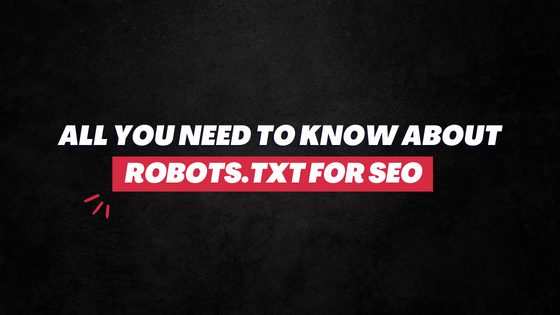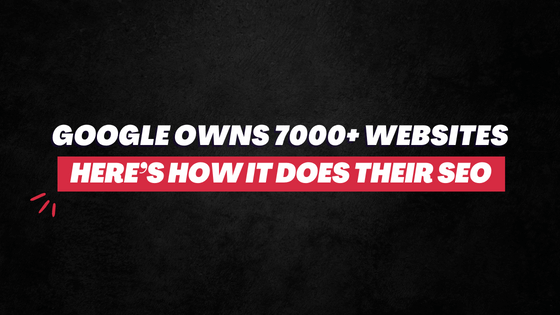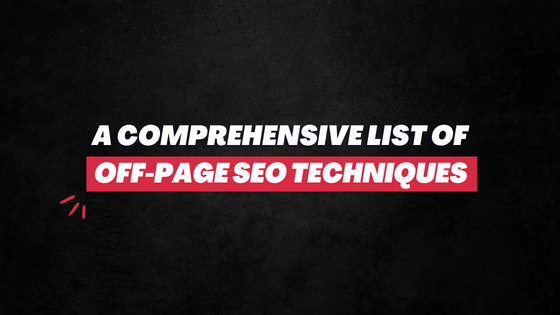These classic SEO tactics are now outdated. Well, not entirely—but they are.
All thanks to Google RankBrain Algorithm.
If you haven’t read already, read what is RankBrain.
In short…
RankBrain is Google’s machine learning ranking program that understands the intent behind search queries, analyzes users’ behavior and then regularly revises its result pages based on its newly acquired information.
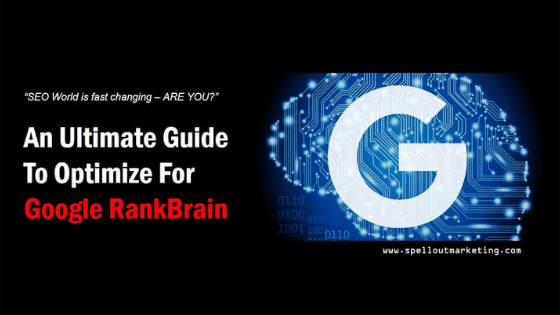
This AI program – first confirmed by Google in late 2015 – is the third most important ranking factor. Only behind content and links.
Now comes the important question, how do you optimize for RankBrain?
Incidentally, the good people at Google have answered that as well.
 |
- It’s not an official statement from Google.
- It’s a Mid-2016 Report. RankBrain has significantly evolved since then.
- ‘Write in natural language’ is an indirect way of saying write quality contents that are meant for humans and not Google.
So, the easiest way to tackle RankBrain is to do what Google is asking for—produce high-quality contents that users find VERY HELPFUL and worthy to engage with. The rest, leave that to this search engine.
Yes, I know, it’s quite vague!
Thankfully, there are ways.
Over the course, the SEO world has come about to know a lot of things about RankBrain and how it influences the ranking. It largely comes down to how it functions.
If you want to know about the technical details on how RankBrain works, this post on Search Engine Journal by Kristine Schachinger is a nice read. If you’re short on time, read a smaller version here (Google RankBrain 2018).
How Google RankBrain Works?
In simplified terms here’s how RankBrain works in two different, yet connecting, parts:
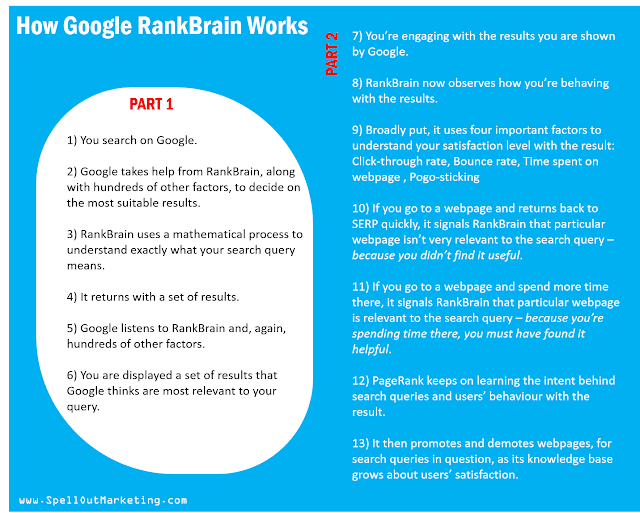 |
1. You search on Google.
2. Google takes help from RankBrain, along with hundreds of other factors, to decide on the most suitable results.
3. RankBrain uses a mathematical process to understand exactly what your search query means.
4. It returns with a set of results.
5. Google listens to RankBrain and, again, hundreds of other factors.
6. You are displayed a set of results that Google thinks are most relevant to your query.
PART 2
7. You’re engaging with the results you are shown by Google.
8. RankBrain now observes how you’re behaving with the results.
9. Broadly put, it uses four important factors to understand your satisfaction level with the result:
- Click-through rate
- Bounce rate
- Time spent on page
- Pogo-sticking
Also Read: How to increase organic click-through rate
10. If you go to a webpage and returns back to SERP quickly, it signals RankBrain that particular webpage isn’t very relevant to the search query – because you didn’t find it useful.
11. If you go to a webpage and spend more time there, it signals RankBrain that particular webpage is relevant to the search query – because you’re spending time there, you must have found it helpful.
12. PageRank keeps on learning the intent behind search queries and users’ behavior with the result.
13. It then promotes and demotes webpages, for search queries in question, as its knowledge base grows about users’ satisfaction.
In an extremely simple way, that’s how Google RankBrain works.
It’s pretty clear now from point number 9 that this machine learning ranking program observes users’ experience and adjusts its results based on four simple factors: CTR, Bounce Rate, Dwell Time and Pogo-Sticking.
 |
- Increase Click-Through Rate
- Decrease Bounce Rate
- Increase Dwell Time
- Decrease Pogo-Sticking
Sounds fair and clear?
Now with the basic picture clear on what is RankBrain and how RankBrain works, we can come to the important question of the topic that DOES NOT HAVE A VAGUE ANSWER…
How to Optimize for RankBrain?
Here are 7 Powerful Tips:
1) Do not concentrate on just one keyword or phrase
…use multiple keywords. Sprinkle all the variations. Don’t overlook the importance of LSI keywords.
Besides the fact that 96 percent of all search queries in the USA have less than 50 searches per month, keyword density doesn’t influence Google ranking anymore.
If you’re using the same keyword over and over again in an article (sort of spamming), it won’t help your case.
First, if your article ever manages to get to the top, Bounce rate and pogo-sticking would be high because of its poor quality. It will eventually get demoted.
Second, RankBrain understands different variants and phrases of your primary keywords. It understands “become happy tips” and “tips to become happy” have basically similar meanings.
So why not leverage its intelligence? Why risk spamming by using one phrase, unnecessarily, countless times? Why not tell Google what your content is all about by plugging varieties of keywords and phrases?
So write articles based not just on one particular keyword, but on one concept where you can fit in as many relevant primary and secondary keywords with their diverse variations.
Also Read: How to do keyword research for free in 11 minutes
2) Hunt for a Promising and Interesting Headline
When you see a set of results on SERP. How do you decide which one would you click on?
Of course, by its headline.
The relevance of an attractive headline couldn’t be said enough. As much we’re advised against it, we do judge books by their covers.
According to a study…
8 out of 10 people will read your headline and only 2 people will go on to finish the article.
Say you managed to get your article on the first page of Google. But if its headline isn’t good, nobody will click on it. And if the CTR is low, RankBrain would eventually demote it down.
So come up with the best blog headlines that are magnetic, promising, intuitive, and interesting.
Also Read: 9 Blog Headline Best Practices
3) Get over that ‘Keyword Rich Meta Description’ mindset
Next to headline, what a user would see is the search description or Meta Description.
This little snippet will play a convincer to the users. In limited characters, it would tell them about your content—what it is and what it will offer them.
If that person finds it interesting, she or he would click on that. Otherwise, there’s plenty of fish in the pond.
So you’ve got to create good snippets. This also means you need to get over that “keyword-rich description tag” mindset which tells you to stuff as many keywords – as many times – in these posts’ snippets, even when it makes no sense.
Stuffing keywords in description tag unnecessarily don’t affect SEO as much as it once it. Plus, meaningless snippets, made to flatter the search engines, only repels the humans.
This leads to poor CTR.
So be thoughtful when creating Meta description of your articles. Don’t focus on the search engine. Focus on humans.
I am not saying you should entirely ignore keywords here. Just make sure the snippet actually makes sense and is enticing enough to get people to click on the link.
4) First 100 Words Will Win (Or Lose) the Game for You
It’s no secret. The opening few lines of your article are very important. And Neil Patel knows this well…
 |
So in short, roughly, the first 100 words of your article will either win or lose the game for you.
It must be engaging and interesting enough that grabs the readers’ attention and glue them to what you’re about to say next.
This is one of the many reasons why throwing a fact or statistic right at the beginning of the post is such a popular practice among bloggers. Numbers immediately captivate readers.
Second, you must avoid being vague and boring in these 100 words.
If people have landed on your page with “how to do yoga” search query, they wouldn’t want to know about types of yoga, its history and why it’s healthy. They would simply want to know how to do it. Right?
But when you start talking about anything that they aren’t looking for – or anything that’s less interesting – they would automatically stop reading it and leave your page.
So, get directly to the main point without wasting even a second.
One of the things Brian Dean of Backlinko uses in his post is Bucket Brigades.
Here’s how he describes it…
 |
Look… Stop everything… I can’t do it… these are examples of BB that actually get readers’ attention and makes them wonder “what next”.
Here’s a beautiful explanation on this topic by Ana Hoffman of Copy Hackers—what is Bucket Brigade and how you can use it:
5) It is a Conversation and Not ‘Best Writer Contest’
Blogging is way different than writing. It’s about how you’re communicating with the audience – and not necessarily telling or informing them.
Meaning to say, blogging is about having a conversation with the readers. It’s not a writing contest where you’re supposed to show your vocabulary and grammatical prowess.
Nobody cares how you’re saying. All it matters is what you’re saying.
So your articles must be written in an informal way like your reader is sitting right in front of you and you’re talking to her or him directly.
It should have a natural language and natural feel. This is how you connect with the audience, engage them and make them stick around the page for longer.
Because they would feel someone is talking to them. And they would want to listen to it.
Besides, unless you’re writing a novel, nobody likes flowery and difficult sentences that they have to think on for a minute to fully understand.
In short, to prevent pogo-sticking and to increase dwell time, converse and not tell in your articles.
7) Champion Internal Link Building
Whenever we think of internal links, we think of search bots first.
Linking pages with each other will help the spiders crawl better!
But when optimizing for RankBrain, you need to think of internal linking in sync with humans.
To avoid 100 percent bounce rate, you need to tell the readers that there are other contents that they might find equally helpful. “Tell them” is an important word here.
I see bloggers sloppily linking their web pages back and forth by hyperlinking single words or phrases anywhere in the content. Here are two things to note:
(i) The anchor texts should always be keywords and not “any word”; and
(ii) Yes, search spiders might see the link and crawl to the next page— but readers might not. They might not know they are supposed to click on that link. They are not told what’s on the other side of that link.
So even when they read and liked the post, they might eventually leave. Because they are not told what to do next. So your bounce rate remains high.
A simple solution to this is to tell your readers what to do next and give them options.
First, include different – and relevant – articles in the content using “Also Read” or “Recommended Read” Call to Action. Tell the readers what other things they can do. Like this…
Also Read: How to get free backlinks for your new blog
Second, always end your post with a Call-To-Action.
Third, after the end of the post, install a ‘Related Post’ widget.
6) Ask “Is the Content Digestible?”
A piece of content with no proper formatting, no paragraphs, just plain text is simply too much to take in.
People want articles that they can easily browse and understand. This is one major reason why list-based posts are so popular these days. Because they are easy to consume.
So you must create articles with proper formatting that are easy to understand even on a single glance or browse.
Use short sentences. After every 3 sentences, a paragraph change is a must. The entire post should be properly organized into different headings, categories, and numberings.
When people see a clean and organized piece of content, they are more likely to stay and consume in than a post that’s complete chaos of words.
8) Say Goodbye to Plain Vanilla Content
Our attention span is now 7-seconds – less than that of a Goldfish. We can’t continuously focus on one thing for very long.
Meaning, if a person is reading a text-rich article, she or he will lose interest and get bored of it very quickly. And then eventually leave…
Including multi-media files throughout the post is essential today. Plain, only-text contents are the thing of past.
You need to include images, infographics, and videos in the post to not only supplement what you are saying and enhance its value but to also provide visual appeal to the readers. So that they don’t get uninterested very quickly.
Also Read: How to use interactive contents to increase SEO ranking
CONCLUSION
Keeping the top two ranking factors aside (links and contents), Google SEO is fast becoming all about ‘Google RankBrain SEO’.
This AI ranking system is combining the power of countless other ranking signals – including the links and contents – to deliver what it believes high quality and the relevant result to the users—and without any human interference and administering at that.
This is quite fitting though, given the fact the world is moving ahead towards the machine learning era. Why should search engines not have their own brain?
If you want to rank on Google, you have got to champion its Google RankBrain algorithm.
Thankfully, it isn’t too difficult. Just follow the above 8 steps and you’re good to go.
Recommended Read: Google BERT Update Explained: Everything You Need to Know
If you liked this post, please share it on social media. 🙂
